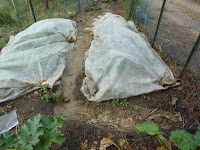The Colorado climate has many advantages for growing. Little
humidity and lots of sun reduce the number of diseases and pests to contend
with. But wind, hail, wildlife, high elevations, and limited water challenge
even the most experienced of gardeners. Here are some easy and fairly cheap strategies
to help us beat these challenges.
Floating Row Covers
These lightweight breathable fabrics come in various
thicknesses and will offer frost, hail, and wind protection. Use floating row
covers at the beginning and the end of the season to protect plants from frost
damage, by providing a few degrees of warming depending on the thickness. The
row covers don’t need any support, just tie them down with rocks, staples, stakes,
or sandbags. Make sure they are secured tightly, especially if you are using
the fabric to prevent wind damage. Hoop frames can also add additional
protection from hail.
 |
| Floating row covers are a great tool for gardeners. |
In addition, floating row covers can reduce wildlife
browsing on your salad greens and vegies. Elk, deer, moose, rabbits, and
chipmunks sniff at the beds, but they can’t get inside the row covers to eat anything.
Does anyone have trouble with flea beetles, grasshoppers, or other bugs in your
garden? Floating row cover will also prevent insects from eating away at your
crops.
Floating row covers seems to solve a lot of challenges! One
thing to remember though is that tomatoes, peppers, eggplant, squash, and
tomatillos need wind or bee agitation to transfer pollen. These plants should
be uncovered for pollination once they flower. Also uncover plants you are growing
for harvesting seeds. But plants like beets, salad greens, beans, and peas can
stay covered for the whole growing season if needed because they self-pollinate
easily.
For some reason, I don’t see floating row covers in garden
stores, but they can be purchased in rolls online, such as from Johnnie’s
Select Seed Company. Shop around for the best prices as they can be pricey.
Also consider what thickness you want based on your needs. Agribon19 is what I
use.
Small Hoops or Low
Tunnels
 |
| Low tunnels add additional hail, wind, and frost protection. |
Adding hoops to form a low tunnel will add additional frost
protection (2-6 degrees F) and can add two to six weeks on each end of the
growing season. Combine hoops with floating row covers for even more frost
protection.
Make hoop frames out of PVC pipes, 6-or 9-gauge wire, or
bent electrical conduit. Cover the frames with 6 mil UV-resistant plastic,
which should last 3-5 years. The plastic must be held up off plants, as plants
will freeze where touched by the plastic. Use clips or clamps to keep plastic
taut and in-place around the hoops, and weight the sides down with sandbags or
rocks.
Don’t forget to vent your plastic tunnel on sunny days to
prevent overheating. They do make slitted plastic covers which automatically
ventilate, but these provide less cold protection.
 |
| Exclude critters by putting wire protection on the bottom of the beds. |
Hardwire Cloth
Hardwire cloth, or wire mesh will prevent pocket gophers
from entering your garden. The wires must be no more than ¼” apart.
It is
easiest to install if you are building raised beds, simply add the hardwire at
the bottom and sides of the beds. Purchase hardwire mesh at any hardware store.
Waffle Gardens
Just as the shape of a waffle collects butter and syrup in
the depressions, you can shape your garden bed to collect and hold water. This
technique was developed by native American Zuni in New Mexico to grow crops
with variable water conditions. Make small mounds or berms in the shape of
squares, one foot or larger, and plant your crops in the depressions. Plants
can be denser than normal to shade the soil and deter weeds. The squares will
hold water and prevent run-off, conserving our precious water.
 |
| Waffle gardens can help save water. |
Harvest Rainwater
As of August 2016, Coloradoans can collect in rain barrels,
up to 110 gallons of rain water off a single family (or up to 4-family unit)
residence. Supplement the rain barrel water by directing overflow rainwater
into the garden with berms and hoses.
 |
| Rainwater is directed from house downspouts into garden. |
By Jennifer Cook, Front Range Small Acreage Specialist, CSU Extension/USDA-NRCS

No comments:
Post a Comment